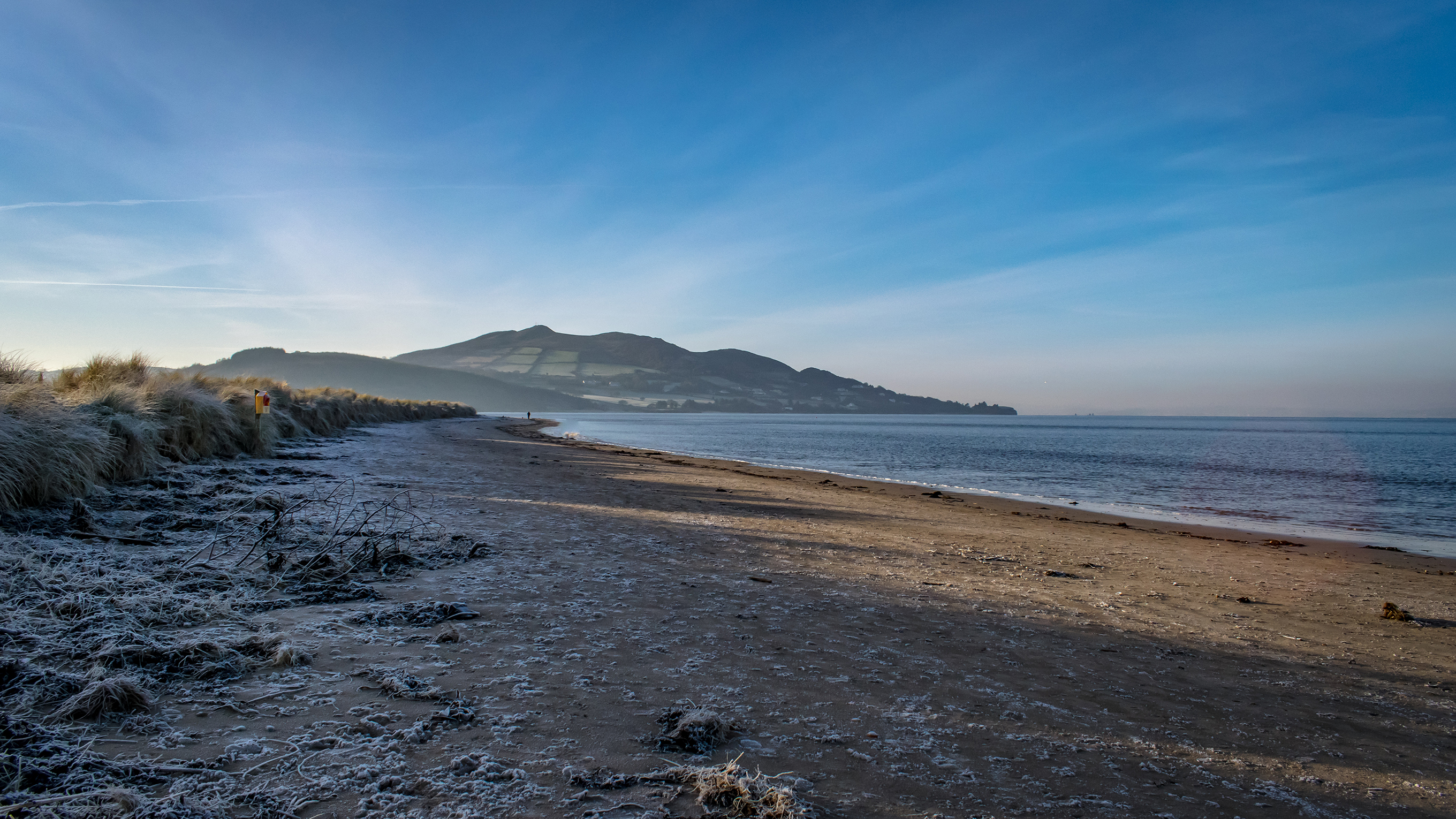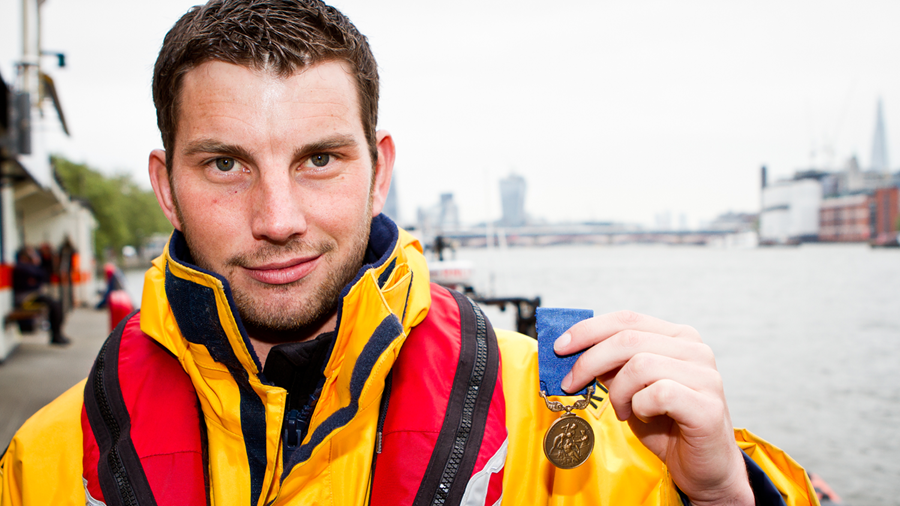

Supporter story: my experience of hypothermia
Cold water swimming and dipping is increasingly popular but comes with risks. One of the most common things to go wrong in the UK and Ireland is hypothermia. Here, RNLI supporter Seacailín McLaughlin shares her story.
It was New Year’s Day 2025. I’d intended to go swimming in the morning but time got away from us, so I went down to the water with my partner Mark and our dog towards the end of the day. It was 40 minutes before dusk, and I went into the water straight away. Mark said: 'There's no room for error, you’ll need to come back in time.'
I’m an experienced swimmer. I used to swim competitively for Derry City and, about 4 years ago, I started swimming in the sea almost every day. I swim with a group or on my own, with Mark or my daughter on the beach keeping watch.
I wore my swimming costume, goggles and hat and had my Dryrobe and slippers on the beach. It was cold but not too bad. I swam around for a while looking at the skyline and it was beautiful. After about 10 minutes in the water, I thought: 'I’ll get out now' and turned to swim back to shore.
'What if I'm wrong? What if I fully don’t know where I am?'
I’d swum in this area of Lisfannon Beach, Inishowen, about 30–40 times, but when I reached shore I realised that I’d ended up in a different place from where I’d started. I wondered if maybe the sea had pushed me down the beach a bit so thought I’d swim round to where I’d started. As I waded back in, a wave knocked me over and the thought flashed through my mind: 'What if I'm wrong? What if I fully don’t know where I am?'
The tide was coming in now and I could see a marsh above the rocks that I was quite familiar with, so I thought I’d get up onto it. But once on the marsh, there were brambles and rocks all around me. Then all of a sudden it was dark. I called out to Mark, shouting his name and hoping he’d hear me, so he wouldn’t panic. I was afraid he’d think I’d drowned.
Initially I felt warm and energised – I wasn’t worried. I walked up and down the marsh, knowing my legs were being scratched by the brambles, but unable to really feel it. I was mildly hypothermic but knew very little about hypothermia at the time.
What is hypothermia?
Hypothermia is a condition where the body’s core temperature has fallen below 35°C. Normal body temperature is around 37°C. Hypothermia can strike whether you’re in the water, on it, indoors or outdoors, at any time of year in the UK and Ireland.
Then I realised my legs were torn to shreds and I started to think I was never going to get off the marsh. I could see a little house on the edge of the marsh but I didn’t recognise it. I began to feel anxious. I told myself not to panic.
Before long, it was really dark and I thought: 'I could be in trouble here.' But I somehow still felt okay – warm, even though I only had my swimsuit on.
'I was shaking and my teeth were chattering'
Meanwhile, Mark had begun a search. He’d gone to the nearby house and asked someone there to shine their car headlights onto the marsh. That’s when they saw me waving. I think we were all flooded with relief. I’d been missing for over an hour.
There was a massive ditch of brambles between us, but Mark threw a torch to me and I picked my way down along a little path on a rock.
Mark was in a state. He thought I’d drowned. I put my Dryrobe on but when I got into the car, I was shaking and my teeth were chattering.
We went home and my neighbour, who used to be in the Army, said I needed to go to hospital because I might have hypothermia. We rang emergency services and the ambulance came out. The paramedics assessed me and said I had mild hypothermia but didn’t need to go to the hospital.
They made sure I didn’t have anything wet on, treated my cuts – which they said were superficial – dried my hair, put a warm hat and woollen socks on me, then laid me on the sofa wrapped in a tinfoil blanket. The next day, I got a tetanus vaccination and some strong antibiotics.
'Experiencing hypothermia taught me a few things'
The thing for me is how easily a beautiful moment can turn into a bad situation. In a time when so many people are taking to the sea, I want to share my story with you in the hope it can help to keep you and the people you care about safe.
Experiencing hypothermia taught me a few things. I would advise taking a tow float and wearing a waterproof watch to time how long you’re in the water. I would also be aware of the water temperature and the possibility of hypothermia. And I would not leave it so late in the day. I wouldn’t swim anywhere I don’t know.
How hypothermia affected me
Tim Doran, RNLI National Water Safety Partner, marathon swimmer and surfer, shares his experience.
I enjoy sea swimming and dipping all year round on the west coast of Ireland. They're a refreshing and invigorating way to get outdoors. But hypothermia can catch you off-guard.
It was early May a few years back and I was enjoying my Sunday morning dip in the north Atlantic waves with my local bathing club. Bodysurfing close to the shore in shorts was a novel experience. Normally I'd stay in for a few minutes and get out while I still felt warm, but 40 minutes had now passed. I thought being first in and last out would be a great achievement!
But I realised that my hands were doing a claw, I couldn’t move my fingers, and even standing up in the shallows left me feeling uncoordinated and off balance.
I walked back to my bundle of clothes and changing robe, did the sandy dance back into warm and dry layers, and was now shivering uncontrollably. Approaching the six or seven steps off the beach I knew that I really had to focus and fight the confusion in my head. Gripping the cold metal handrail tightly, I made it onto the path, then shuffled round to my colleagues inside the beach lifeguard hut.
Extra layers, warm drinks, and knowing I was surrounded by the lifeguard team reassured me. An hour later, I was back to normal.
Looking back, I'm grateful to have had this experience of mild hypothermia. I use the lessons I learned every time I dip or swim – and with a greater respect. It’s also a great reminder that the sea doesn’t care if you’re a lifelong swimmer, surfer or lifeguard. The cold will affect us all.
The best way to avoid hypothermia is to listen to your body and know your limits, get out before you feel the cold in your core. And if in doubt, don’t go out.
The stages of hypothermia and how to treat it
-
1
Beginning to get cold
As you get cold you start to shiver, which is the body’s way of trying to warm itself up. At this early stage you’re still aware of your surroundings and hypothermia hasn’t set in. Warm yourself up and have a warm drink.
-
2
First signs of hypothermia
If your temperature drops further, the first signs of hypothermia include confusion, loss of coordination, stopping shivering and becoming rigid – sometimes in the foetal position.
-
3
Call for help
If you’re with someone who seems to be hypothermic, call for medical help and consider evacuating them to safety.
-
4
What not to do with hypothermia
Don’t actively warm up a hypothermic person with warm drinks or a warm shower. Don’t give them whisky or similar, as alcohol lowers our core body temperature.
-
5
Remove wet clothes
Treat the person with hypothermia gently. Ask them to remove any outer layers of wet clothing and ask them for consent if they need your help doing this.
-
6
Cover up
Wrap them in blankets and a waterproof cover. Also cover their head.
You may also enjoy the following









